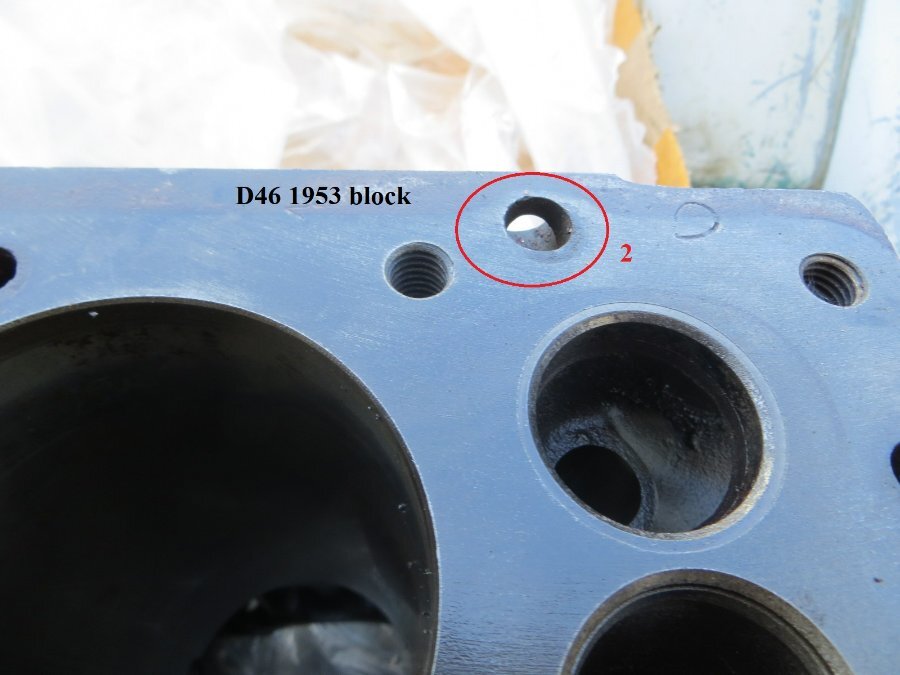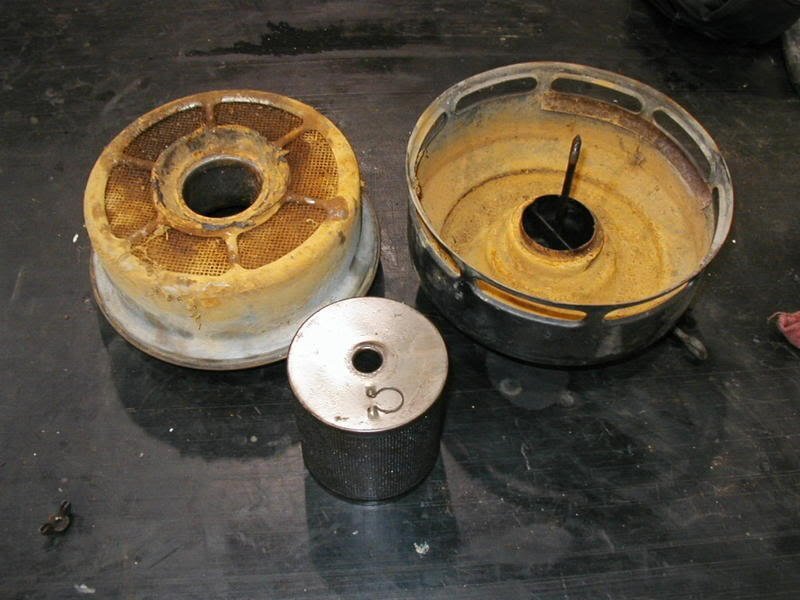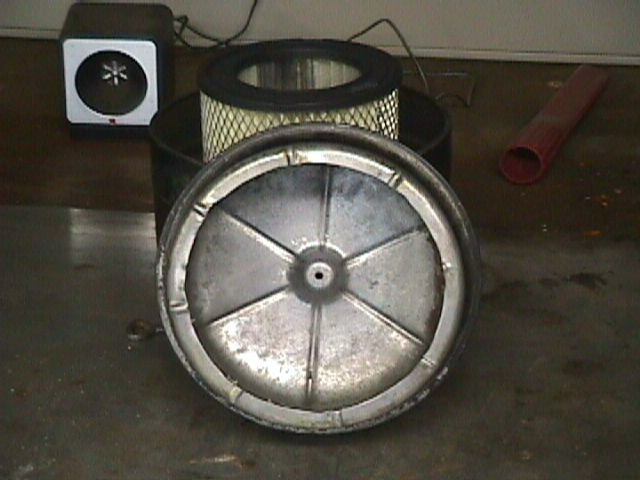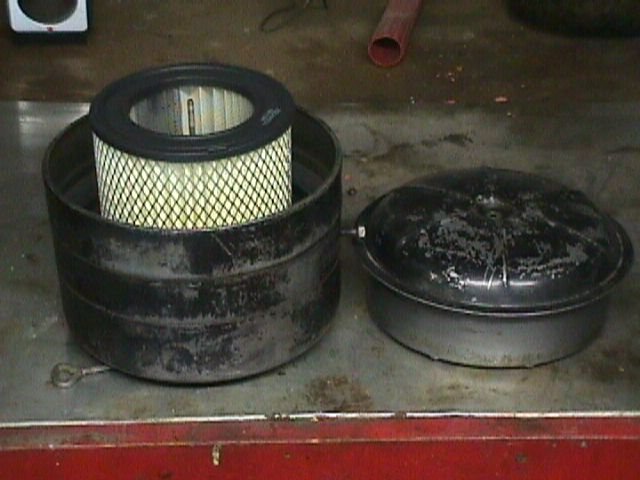-
Posts
1,612 -
Joined
-
Last visited
-
Days Won
13
Everything posted by Bryan
-
Thanks..I just came from the garage and measured the front of the hole. It's exactly 0.4375" or 7/16 smooth. Which would get a 1/2-13 plug. The hole on top of the elbow was a little larger. I also was cleaning the threads up on the hole next to it for the water pump..someone bunged the threads up.
-
I've been using brake cleaner on about everything.
-
Appreciate the offer but already have the two heads. Don't mind using the external bypass, just don't want it to leak. Looking at it, have the options of changing the new water pump back plate (and trying to find a gasket), plugging the hole with a freeze plug type like you said (if I can find one that small), and wondering if I could fill a hole that size in the block with welding, and grind it off? Or, lastly, thread the hole and screw in a plug with sealant?
-
Tried to follow up on this but found what I posted is in the truck forum. Just noticed I have an internal bypass block and 2 external bypass heads. https://p15-d24.com/topic/5866-water-pumps/?do=findComment&comment=622144
-
Just noticed: Got a problem with my newer 1953 internal bypass block and 2 external heads. Previous posts talk about its okay to put the new water pumps with the small internal bypass hole in the rear on an external bypass block (no hole), since the flat metal seals the hole. What does one do if the opposite is the case, an internal bypass block (small hole) with an external head? Don't like the way it looks so close to the edge of the head. The new water pump has a larger plug for the top flange, but no plug for the small hole on the rear. Plus the gasket has the hole. Any suggestions on a reliable way to fix this? Anyone fixed this in the past and it held up and didn't leak?
-
Noticed even on the newly cleaned block the main oil galley still looks rough. Going to find a rotary wire brush or some tool to run through it
-
-
Another thing I'm noticing is both pistons from the new & old blocks had a spacer on the top land, to get a 3/32" width. I'll definitely keep an eye on that too.
-
It's good to know that manufacturing tolerances are that much off. I didn't know it. But now knowing the differences in compression height between 3 brands of pistons helps. If you have a flat block top, don't deck it and go with the 2.000 CH pistons. If the top is warped, have it decked and go with the .02 lower ones. Imagine how pissed I'd be if I didn't know this, didn't deck the block, got the .02 lower pistons, had the head milled .04 and wonder why it didn't change much. For practical purposes as you say, we don't have a bunch of parts to try out..just the 6 pistons in the order.
-
Only thing wild I have is a speedometer light that changes color as you get faster. Think red, yellow, green. Might be a year before I get it running.
-
-
And thanks very much on that. I have a MS WORD file on salient points you and others have mentioned during videos. Also any problems that you and others note, I put it on a list to remember. Just like the oil galley leak in the rear, I'll definitely do the plug myself and add an core plug on top. And like Dodgeb4ya's comment on double brass core plugs in the rear, I'll buy them extra and use them. I really helps to hear issues and fixes. Thanks again.
-
On changing my transmission mount on my 1992 Dodge Dakota the new bolt with the mount was 1/4 longer than the original and changed to metric. After struggling with trying to get the mount in for 1/2 hour, I finally figured the problem out and ground 1/4 off to get the mount in. Then I thought I had buggered the threads on the end by grinding, until I finally figured they switched it to metric. A lot of weird crap can happen.
-
Don't know, Ratbailey is going to try it out. Will wait to see how it goes.
-
The new Chinese knock offs on EBAY have YF types running $65-$75, YFA $75-$95. I have used a $20 brand new knock off carb on a 4 wheeler. Worked fine, couldn't tell the difference. I'm going to try to rebuild my old carb, and if that doesn't work I might be joining you on it. I try to stay original but just like when I broke my exhaust manifold, I'm not paying 5x-10x the price for the "super rare" "I only have it" part. Whatever runs well and is reliable.
-
Something flat like an unsanded primer surface might hold dirt more. An even, sealed satin type finish might look old enough, like Decotant was saying. Know what you meant, that it did not come like that. You just want it to look old and not be too expensive.
-
The machine shop called yesterday that my block and 2 heads are ready. Had all tanked, blasted and magnafluxed. He said none of them have cracks. He said the cylinder measurements would call for a close .020 oversize, but said I'd be safe with .030 oversized pistons. Was saying you might have a few spots on the cylinder if he did a .020. I told him I'd go with a .030. We discussed the compression height issue and he affirmed "rebuilder" pistons were usually .02 lower. I told him I measured the flatness of the block and it looked good to me. I ask him to also back-check me and check the flatness also. If it's flat I'll get the EGGE pistons with 2.00 CH. Asked him if he oiled the block, he said most people don't want that. I told him it might be a while before I get it back to him, he'll spray it down. He said the cost of all should be about $280. Will go next week when I get money from savings. Also asked him about valve seats. He said they usually replace only the exhaust seats. Presently working on my home security system and having back muscle problems..too much leaning over to wire RJ45 jacks
-
Somebody a long time ago (don't know if on this forum) about converting the filter. Pictures in reverse order.
-
First thing I've been mentioning is compression height, not deck height. I'm not fixated on deck height. Also not fixated on achieving an exact compression ratio. I have 2 heads and that is all I'm going to use, one or the other. I'll use some of your methods and maybe sacrifice a gasket, will mill the head a safe amount. What are all these different NOS and other brand (CAST) pistons? I've seen Silvolite 1280, Sealed Power 37P, EGGE and VPW NOS pistons (their normal ones they don't say what they are). If you mean other Chevy, Ford, Toyota, etc pistons I'm just not doing that. If you've seen my posts you know about the level of complexity I'm comfortable with. Might be great for you and others, and I've done that when I was in my late 20s with motorcycles, but not now.
-
It's okay..most people didn't but I wasn't trying to get an exact list. The numbers give you a range of .072-.080 new and .040 to .052 compressed. If I took worst case compressed (for not banging the piston on the head) I'd use .035..
-
So, looking through various posts: Sniper on Dec 2021 -> Best brand gasket, listed info, not measured was nominal .080, compressed .052 =/- .002 Kencombs' Milled head post -> .040 compressed. Don Coatney -> .072" measured from composite/copper gasket. Thebeebe5 -> .075" Felpro, good quench is .035-.040". Plymouthy Adams -> compressed gasket at .043"
-
On another post I noted that the top of my block is flat to .0008". Not kidding. Could have it decked .02, but first trying to figure out if what I'm seeing is correct, that some pistons come with a compression height .02 lower than stock. Just came from my shop and measured the pistons that came out of the first block (the 48 Dodge). The wrist pin measured .8595" (again). From bottom of pin to top of piston measured 2.4350". The piston out of the 53 block previously measured 2.4295-305". Doing the math gives .8595/2 = 0.42975" Subtract that from 2.4350 and it gives 2.00525. So I "assume" the stock compression height must be 2.000". I also did something a little strange, I put the piston back in the block with the top ring on it. It stops consistently on the ridge with the piston sticking out .05-.06 above the deck. Wonder if this what it's actually doing when the engine is running? For me personally (not anybody else) forged pistons is a little too much. On gaskets I bet if I search or ask on the forum I'll find the different thicknesses. I would think knowing the 3 different available compression heights out there (1.980, 1.978 and 2.00) I would have the machine shop tell me with my crank what the deck height is before decking the block. Main goal is not to have the piston hitting the flat part of the head, which doesn't change height no matter how much the head is milled. I might CC the head initially, but I can't go back and forth to the shop trying for an exact compression ratio. Seen what you have done, and it's great details, and would be nice to do. But I'm planning to just have the head milled a safe amount one time, some say max .060, some max .080 but no more than that (probably .060). Don't want to be dealing with warped heads and leaking gaskets. I will start researching the gaskets.
-
If EGGE pistons are true 2.00 compression height I might spend the extra $100 for them. I'll call them my "custom back to normal" pop up pistons. And dang, just another $400-500 I could get custom Ross pistons. I need to stop.. ?. Will settle for the EGGE ones.
-
Anybody out there? This is Lawrence, Kansas..
-
Not yet,,but here's something on the same topic. Will get to it. Never realized there was such a thing as "rebuild pistons" ..Chevy 350 rebuild questions | Hot Rod Forum (hotrodders.com)









